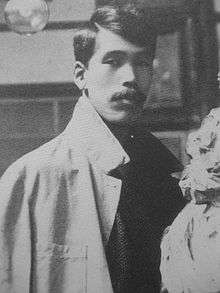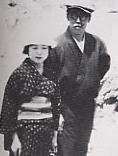Kōtarō Takamura
Kōtarō Takamura (高村 光太郎, Takamura Kōtarō, March 13, 1883 – April 2, 1956) was a Japanese poet and sculptor.
Kōtarō Takamura | |
|---|---|
 Kōtarō in 1911, aged 29 | |
| Native name | 高村 光太郎 |
| Born | March 13, 1883 Tokyo, Japan |
| Died | April 2, 1956 (aged 73) Tokyo, Japan |
| Occupation | Poet, writer, sculptor |
| Nationality | Japanese |
Biography
Takamura was the eldest son of Japanese sculptor Takamura Kōun. He graduated from the Tokyo School of Fine Arts in 1902, where he studied sculpture and oil painting. He studied in New York, at the Art Students League of New York City in 1906. While in New York Takamura studied under the well known sculptor Gutzon Borglum. Takamura's time spent in America was hard and had great impact on his sculpture work and literary work. Takamura additionally studied in London in 1907, where he met his best friend Bernard Leach[1]. Finishing his studies in Paris in 1908, returning to Japan in 1909[2], and lived there for the rest of his life. His sculptural work shows strong influence both from Western work (especially Auguste Rodin, whom he idolized) and from the Shirakabaha society. Takamura dedicated his artwork style to separating itself from the traditional Japanese style of art. Takamura and other artist were seen as leaders of a revolution in Japanese artwork.[3]

He is also famous for his poems, and especially for his 1941 collection Chiekoshō (智恵子抄 literally "Selections of Chieko", in English titled Chieko's sky after one of the poems therein), a collection of poems about his wife, the oil painter, paper artist and early member of the Japanese feminist movement, Chieko Takamura née Naganuma, who died in 1938.[4] In 1951 Takamura received the 2nd Yomiuri Prize.[5]
Published works
- Chieko's sky, 1941 (English translation 1978) - ISBN 0-87011-313-5 (English)
- The Chieko poems, bilingual edition, 2005 - ISBN 1-931243-97-2
References
- Hirakawa, Sukehiro (1989). "Takamura Kōtarō's Love-Hate Relationship with the West". Comparative Literature Studies. 26 (3): 214–233. JSTOR 40246676.
- A Brief History of Imbecility, Hiroaki Sato, University of Hawaii Press, 1992, xv-xvi
- Schoneveld, Erin (2019). "Revolutionary Art, Revolutionary Artists". Revoltionary Art, Revolutionary Artists. doi:10.1163/9789004393639_006. ISBN 9789004393639.
- Birnbaum, Phyllis (January 22, 2015). Modern Girls, Shining Stars, the Skies of Tokyo: Five Japanese Women. Columbia University Press. ISBN 9780231500029.
- "読売文学賞" [Yomiuri Prize for Literature] (in Japanese). Yomiuri Shimbun. Retrieved September 28, 2018.